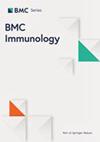在喀麦隆,KIR2DL1 基因是保护未暴露于 HIV-1 病毒与暴露于未感染病毒的婴儿免于感染相关住院治疗的替代标志物
IF 2.7
4区 医学
Q3 IMMUNOLOGY
引用次数: 0
摘要
与未感染艾滋病毒的同龄婴儿(HUU)相比,暴露于艾滋病毒的未感染婴儿(HEU)似乎更容易受到感染,这通常归因于从母亲那里获得的被动免疫能力较差。这可能是由于某些可能改变免疫系统的遗传因素造成的。因此,我们试图确定 HEU 与 HUU 中杀伤细胞免疫球蛋白样受体(KIRs)基因的分布情况,并研究它们与感染相关住院的发生率之间的关系。从 2019 年 5 月到 2020 年 4 月,在雅温得-喀麦隆的参考儿科中心对 HEU 和 HUU 婴儿进行了一项队列研究,包括第 6、12、24 和 48 周的随访。确定了婴儿的艾滋病毒感染状况和感染情况。采用序列特异性引物聚合酶链反应(PCR-SSP)方法对总共 15 个 KIR 基因进行了研究。分析了与 HIV-1 感染状况(HEU 和 HUU)明显相关的 KIR 基因与感染相关住院治疗的关系。只有在感染相关住院治疗因感染状况而有显著差异的情况下,才能进行分析。我们进行了多变量逻辑回归分析,以确定 KIR 基因含量变异与 HIV 感染状况之间的关联,同时考虑了一些潜在的混杂因素。此外,还使用相对风险、几率比和 95% 置信区间对风险进行了量化。采用费雪精确检验来比较发生频率。P 值小于 0.05 即为具有统计学意义。在该队列中,共有 66 名婴儿参与,但只有 19 例感染需要住院治疗(14.81%,04/27 HUU;38.46%,15/39 HEU,p = 0.037)。在第 48 周(39 例 HEU 和 27 例 HUU),HEU 与 HUU 的感染相关住院相对风险 (RR) 为 2.42(95% CI:1.028-5.823),OR 为 3.59(1.037-12.448)。KIR2DL1 基因在 HEU 与 HUU 中的代表性明显不足(OR = 0.183,95%CI:0.053-0.629;p = 0.003),KIR2DL1 基因缺失与感染相关住院治疗显著相关(p < 0.001;aOR = 0.063;95%CI:0.017-0.229)。与 HUU 相比,HEU 的易感性是由 KIR2DL1 驱动的,这表明该 KIR 对感染和住院具有保护作用。本文章由计算机程序翻译,如有差异,请以英文原文为准。
KIR2DL1 gene is a surrogate marker of protection against infection-related hospitalization among HIV-1 unexposed versus exposed uninfected infants in Cameroon
HIV-exposed uninfected infants (HEU) appear more vulnerable to infections compared to their HIV-unexposed uninfected (HUU) peers, generally attributed to poor passive immunity acquired from the mother. This may be due to some genetic factors that could alter the immune system. We thus sought to determine the distribution of Killer Cell Immunoglobulin-Like Receptors (KIRs) genes in HEU versus HUU and study their associations with the occurrence of infection-related hospitalization. A cohort study was conducted from May 2019 to April 2020 among HEU and HUU infants, including their follow-up at weeks 6, 12, 24, and 48, in reference pediatric centers in Yaoundé-Cameroon. The infant HIV status and infections were determined. A total of 15 KIR genes were investigated using the sequence-specific primer polymerase chain reaction (PCR-SSP) method. The KIR genes that were significantly associated with HIV-1 status (HEU and HUU) were analyzed for an association with infection-related hospitalizations. This was only possible if, and to the extent that, infection-related hospitalizations varied significantly according to status. Multivariate logistic regression analyses were conducted to determine the association between KIR gene content variants and HIV status, while considering a number of potential confounding factors. Furthermore, the risk was quantified using relative risk, odds ratio, and a 95% confidence interval. The Fisher exact test was employed to compare the frequency of occurrences. A p-value of less than 0.05 was considered statistically significant. In this cohort, a total of 66 infants participated, but only 19 acquired infections requiring hospitalizations (14.81%, 04/27 HUU and 38.46%, 15/39 HEU, p = 0.037). At week 48 (39 HEU and 27 HUU), the relative risk (RR) for infection-related hospitalizations was 2.42 (95% CI: 1.028–5.823) for HEU versus HUU with OR 3.59 (1.037–12.448). KIR2DL1 gene was significantly underrepresented in HEU versus HUU (OR = 0.183, 95%CI: 0.053–0.629; p = 0.003), and the absence of KIR2DL1 was significantly associated with infection-related hospitalization (p < 0.001; aOR = 0.063; 95%CI: 0.017–0.229). Compared to HUU, the vulnerability of HEU is driven by KIR2DL1, indicating the protective role of this KIR against infection and hospitalizations.
求助全文
通过发布文献求助,成功后即可免费获取论文全文。
去求助
来源期刊

BMC Immunology
医学-免疫学
CiteScore
5.50
自引率
0.00%
发文量
54
审稿时长
1 months
期刊介绍:
BMC Immunology is an open access journal publishing original peer-reviewed research articles in molecular, cellular, tissue-level, organismal, functional, and developmental aspects of the immune system as well as clinical studies and animal models of human diseases.
 求助内容:
求助内容: 应助结果提醒方式:
应助结果提醒方式:


